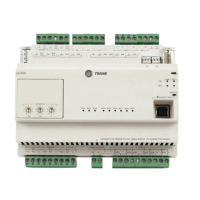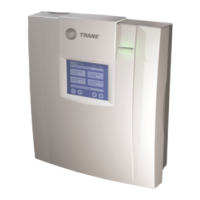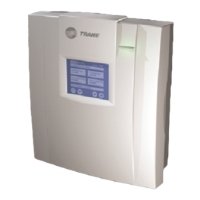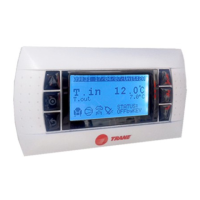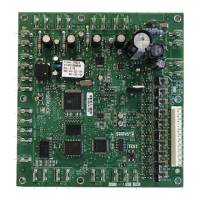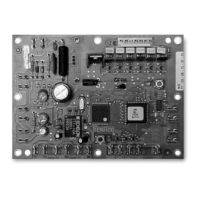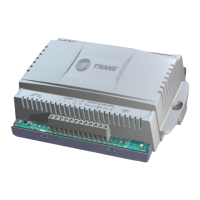BAS-SVX48H-EN
63
Settings for CO
2
-Based Demand Controlled Ventilation
The CO
2
-based DCV sequence used in UC400 Controller is based on the sequence suggested in
the ASHRAE Standard 62.1 User Manual, Appendix A.
NNoottee:: This sequence is intended for a fan-coil, blower-coil, and unit ventilator product that is
applied as a single-zone ventilation system. That is to say, outdoor air enters through an
intake and is delivered to a single ventilation zone, which would be typical of a terminal
unit that is equipped with its own OA damper.
The following describes how to determine the appropriate OA damper and CO
2
setpoints for this
DCV sequence:
• Calculate the required outdoor airflow (V
ot-Design
) at design occupancy using Equations 6-1, 6-
2- and 6-3 from ASHRAE Standard 62.1
V
bz
= R
p
× P
z
+ R
a
× A
z
(Equation 6-1)
V
oz
= V
bz
/ E
z
(Equation 6-2)
V
ot
= V
oz
(Equation 6-3, for single-zone ventilation systems), where
V
bz
= minimum outdoor airflow required in the breathing zone, cfm
R
p
= outdoor airflow required per person (from Table 6-1 in ASHRAE Standard 62.1), cfm/
person
R
a
= outdoor airflow required per unit of floor area (from Table 6-1 in ASHRAE Standard 62.1),
cfm/ft2
P
z
= zone population, number of people
A
z
= zone floor area, ft
2
V
oz
= zone outdoor airflow required, cfm
E
z
= zone air distribution effectiveness (from Table 6-2 in ASHRAE Standard 62.1)
V
ot
= outdoor air intake flow required, cfm
EExxaammppllee:: Consider an example K-12 classroom with a design population (P
z
) of 35 people
and a floor area (A
z
) of 1000 ft2. Table 6-1 in ASHRAE Standard 62.1-2010 requires 10 cfm of
outdoor air per person (R
p
) plus 0.12 cfm of outdoor air per square foot of floor area (R
a
) for
this type of space. The zone air-distribution effectiveness (from Table 6-2in Standard 62.1) is
determined to be 1.0 for this system configuration.
V
bz-Design
= 10 cfm/p x 35 people + 0.12 cfm/ft
2
x 1000 ft
2
= 470 cfm
V
oz-Design
= 470 cfm / 1.0 = 470 cfm
V
ot-Design
= 470 cfm
• Use the same equations to calculate the required outdoor airflow (V
ot-DCVmin
) if no occupants
are currently present in the zone (P
z
= 0).
NNoottee:: This setpoint may need to be increased if the zone requires makeup air to replace air
that is exhausted directly from the zone (for example in a kitchen, a laboratory, an art
or science classroom, or any space with a restroom connected to it). In this case, the
V
ot-DCVmin
setpoint may need to be adjusted so that it is slightly above the local exhaust
airflow to ensure positive building pressurization.
EExxaammppllee::
V
bz-DCVmin
= 10 cfm/p x 0 people + 0.12 cfm/ft
2
x 1000 ft
2
= 120 cfm
V
oz-DCVmin
= 120 cfm / 1.0 = 120 cfm
V
ot-DCVmin
= 120 cfm
• Use Equation A-J from the ASHRAE Standard 62.1-2010 User's Manual to calculate the
steady-state indoor CO
2
concentration (CO
2
space-Design
) when the zone is fully occupied and at
its design outdoor airflow rate (V
bz-Design
).
CO
2space
= CO
2outdoors
+ [1,000,000 x N / (V
bz
/ P
z
)] (rearrangement of Equation A-J) where,
CO
2space
= concentration of CO
2
in the breathing zone, ppm
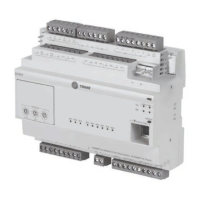
